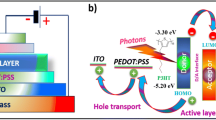Abstract
In this study, considering the information given in the literature the Ullman and Suzuki-Miyaura coupling reactions were carried out using carbazole, 1,3,5 tribromo benzene and aryl boronic acid. The synthesized novel carbazole derivative (CPF4) were characterized by 1H NMR and 13C NMR. The photophysical and thermal properties of the synthesized novel carbazole derivatives CPF4 were investigated Graphene oxide (GO) doped CPF4/p-Si photodiodes were fabricated. The electrical properties of these photodiodes were characterized by current–voltage (I−V) and capacitance–voltage (C−V) measurements. The photocurrent properties of the diode were studied under various illumination intensities. The photoresponse properties of the diodes increased with GO content. The results indicate that CPF4:GO/p-Si heterojunctions can be used as a photodetector for optoelectronic applications.
Similar content being viewed by others
References
Wang C-F, Hung W-Y, Cheng M-H, Hwang J-S, Leung M, Wong K-T (2013) Functionalized terfluorene for solution-processed high efficiency blue fluorescence OLED and electrophosphorescent devices. Org Electron 14:1958–1965. doi:10.1016/j.orgel.2013.04.047
Aydemir M, Haykr G, Battal A, Jankus V, Sugunan SK, Dias FB et al (2016) High efficiency OLEDs based on anthracene derivatives: the impact of electron donating and withdrawing group on the performance of OLED. Org Electron 30:149–157. doi:10.1016/j.orgel.2015.11.026
Kim J-H, Jeon Y-M, Lee HS, Kim J-W, Lee C-W, Jang J-G et al (2008) New asymmetric monostyrylamine dopants for blue light-emitting organic electroluminescence device. Synth Met 158:369–374. doi:10.1016/j.synthmet.2008.02.011
Ameen S, Lee SB, Yoon SC, Lee J, Lee C (2016) Diphenylaminocarbazoles by 1,8-functionalization of carbazole: materials and application to phosphorescent organic light-emitting diodes. Dye Pigment 124:35–44. doi:10.1016/j.dyepig.2015.08.027
Liu Y, Bai Q, Li J, Zhang S, Zhang C, Lu F et al (2016) Efficient pyrene-imidazole derivatives for organic light-emitting diodes. RSC Adv 6:17239–17245. doi:10.1039/C5RA25424H
Kim M, Choi JM, Lee J, Uoyama H, Goushi K, Shizu K et al (2016) Simultaneous improvement of emission color, singlet–triplet energy gap, and quantum efficiency of blue thermally activated delayed fluorescent emitters using a 1-carbazolylcarbazole based donor. Chem Commun 492:234. doi:10.1039/C6CC04516B
Kim M, Jeon SK, Hwang S-H, Lee J (2016) Stable blue thermally activated delayed fluorescent organic light-emitting diodes with three times longer lifetime than phosphorescent organic light-emitting diodes. Adv Mater 28:603. doi:10.1002/adma.201505987 10.1002/adma.201505987
Kim M, Lee J (2014) Engineering the substitution position of diphenylphosphine oxide at carbazole for thermal stability and high external quantum efficiency above 30% in blue phosphorescent organic light-emitting diodes. Adv Funct Mater 24:4164–4169. doi:10.1002/adfm.201304072
Shi H, Li M, Xin D, Fang L, Roose J, Peng H et al (2016) Two novel phenylethene-carbazole derivatives containing dimesitylboron groups: aggregation-induced emission and electroluminescence properties. Dye Pigment 128:304–313. doi:10.1016/j.dyepig.2016.01.028
Grimsdale AC, Chan KL, Martin RE, Jokisz PG, Holmes AB (2009) Synthesis of light-emitting conjugated polymers for applications in electroluminescent devices. Chem Rev 109:897–1091. doi:10.1021/cr000013v
Thomas IIISW, Guy DJ, Swager TM (2007) Chemical sensors based on ampliying fluorescent conjugated polymers. Chem Rev 107:1339–1386. doi:10.1021/cr0501339
Liu J, Lam JWY, Tang BZ Acetylenic polymers: syntheses, structures and functions, 2009, doi:10.1021/cr900149d
Ye J, Chen Z, Fung M, Zheng C, Ou X, Zhang X et al (2013) Carbazole/sulfone hybrid D- π-A-structured bipolar fluorophores for high-efficiency blue-violet electroluminescence. Chem Mater, 2630. doi:10.1021/cm400945h
Reddy JS, Kale T, Balaji G, Chandrasekaran A, Thayumanavan S (2011) Cyclopentadithiophene-based organic semiconductors: effect of fluorinated substituents on electrochemical and charge transport properties. J Phys Chem Lett 2:648–654. doi:10.1021/jz200126s
Jiang W, Duan L, Qiao J, Dong G, Zhang D, Wang L et al (2011) High-triplet-energy tri-carbazole derivatives as host materials for efficient solution-processed blue phosphorescent devices. J Mater Chem 21:4918. doi:10.1039/c0jm03365k
Gelinck GH, Kumar A, Moet D, Van der Steen J-L, Shafique U, Malinowski PE et al (2013) X-ray imager using solution processed organic transistor arrays and bulk heterojunction photodiodes on thin, flexible plastic substrate. Org Electron 14:2602–2609. doi:10.1016/j.orgel.2013.06.020
Lyons DM, Armin A, Stolterfoht M, Nagiri RCR, Jansen-van Vuuren RD, Pal BN et al (2014) Narrow band green organic photodiodes for imaging. Org Electron 15:2903–2911. doi:10.1016/j.orgel.2014.08.015
Lilliu S, Böberl M, Sramek M, Tedde SF, Macdonald JE, Hayden O (2011) Inkjet-printed organic photodiodes. Thin Solid Films 520:610–615. doi:10.1016/j.tsf.2011.08.004
Al-Hartomy OA, Gupta RK, Al-Ghamdi A, Yakuphanoglu F (2014) High performance organic-on-inorganic hybrid photodiodes based on organic semiconductor-graphene oxide blends. Synth Met 195:217–221. doi:10.1016/j.synthmet.2014.06.001
Ma P, Wang C, Wen S, Wang L, Shen L, Guo W et al (2016) Small molecules based on tetrazine unit for efficient performance solution-processed organic solar cells. Sol Energy Mater Sol Cells 155:30–37. doi:10.1016/j.solmat.2016.05.003
Keshtov ML, Godovsky DY, Kuklin SA, Lee J, Kim J, Lim B et al (2016) Design, synthesis and photophysical properties of D1-A-D2-A-D1-type small molecules based on fluorobenzotriazole acceptor and dithienosilole core donor for solution processed organic solar cells. Dye Pigment 132:387–397. doi:10.1016/j.dyepig.2016.05.022
Gao W (2015) The chemistry of graphene oxide. doi:10.1007/978-3-319-15500_53
Caglar Y, Caglar M, Ilican S, Yakuphanoglu F (2009) Determination of the electronic parameters of nanostructure SnO2/p-Si diode. Microelectron Eng 86:2072–2077. doi:10.1016/j.mee.2009.01.062
Phan DT, Gupta RK, Chung GS, Al-Ghamdi A, Al-Hartomy OA, El-Tantawy F et al (2012) Photodiodes based on graphene oxide-silicon junctions. Sol Energy 86:2961–2966. doi:10.1016/j.solener.2012.07.002
Dere A (2015) Photovoltaic and electronic properties of p-Si/C60 solar cell. J Mater Electron Devices 1:7–10
Bube RH (1960) Wiley, New York
Mekki A, Dere A, Mensah-Darkwa K, Al-Ghamdi A, Gupta RK, Harrabi K et al (2016) Graphene controlled organic photodetectors. Synth Met 217:43–56. doi:10.1016/j.synthmet.2016.03.015
Nicollian AGEH (1967) Bell Syst Technol J 46:1055
Acknowledgments
This work was supported by Anadolu University Commission of Scientific Research Projects under Grant No. 1505F310.
Author information
Authors and Affiliations
Corresponding author
Rights and permissions
About this article
Cite this article
Gorgun, K., Caglar, Y. & Yakuphanoglu, F. Synthesis and Photodiode Characterization of Novel Twisted Carbazole Derivatives with 1,3,5-Benzene Core. Silicon 10, 693–702 (2018). https://doi.org/10.1007/s12633-016-9514-9
Received:
Accepted:
Published:
Issue Date:
DOI: https://doi.org/10.1007/s12633-016-9514-9




